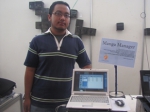After Angklung Robot, Dr. Eko Mursito Budi Successfully Developed Photonic Batik Machine
By Ahmad Fadil
Editor Ahmad Fadil

BANDUNG, itb.ac.id – Batik is a tradition of Indonesia in the form of a cloth that has distinctive pattern. The pattern is drawn by applying wax on the cloth that follows certain pattern. The cloth that has been given wax is dipped in dye solution. Parts that are not exposed to the wax will absorb the dye. Afterwards, the cloth will undergo lorod (soaked in hot water) so that the wax will dissolve, and the pattern will appear from remaining dye. Waxing, dip dyeing, and lorod is done several times to get batik pattern with various colors.
In practice, there are two commonly used dyes, naphthol and indigosol. Naphthol has darker and hard color, while indigosols has brighter and soft color. Hence, the color of indigosol is favored by European consumers for summer fashion. But compared to naphthol, the dyeing process using indigosol is slightly more complicated because it requires photochemical reactions. Traditionally, indigosol dyeing is done in three stages, soaking the cloth in indigosol solution, drying the cloth under sufficient sunlight, and soaking the cloth in acid solution.
The Idea to Replace Sunlight
The availability of sunlight is an important factor to produce batik, especially for indigosol dye. But in Indonesia, the availability of sunlight is often disrupted by rain or clouds. This change in the intensity of the sun greatly affects the quality of indigosol color.
Therefore, an expert in Physics Engineering, Institut Teknologi Bandung (ITB), Dr. Ir. Eko Mursito Budi, M.T, tried to apply sunlight replacement technology in the manufacture of traditional Indonesian batik so that batik can be produced anywhere and anytime, and with consistent quality. The key is to understand the process of indigosol dye activation that depends on photons or elementary particles of light. This machine is then called the photonic batik machine.
The Development Process of Photonic Batik Machine
The effort for Dr. Eko to create a photonic batik machine is not easy. He who had previously successfully created Klungbot (Angklung Robot) must consider many things to integrate all the components on the photonic machine. With the direction of Institute for Innovation and Entrepreneurship Development (LPIK) ITB, innovation products can be classified in 9 Technology Readiness Level (TRL). Phase 1 - 3 is basic research, phase 4-6 is downstream research, while the 7-9 stage is industrialization. In the early days, this photonic batik machine is still in TRL 4 because the science required for indigosol activation is still unknown. Meanwhile, the research target is to reach TRL 7, which is a prototype that is able to work on industrial scale. For this reason, the research of photonic batik machine is done in several stages with the help of students and technicians in Engineering Physics ITB.
His first research on photonic batik machine began in 2015. With a fund of 40 million rupiah he got from LPPM (Institute of Research and Community Service) ITB, he successfully developed the first generation of photonic batik machine. This first generation photonic batik machine is not fully automatic because it still requires human assistance to insert batik cloth into the machine.
"The readiness level of this first generation machine is still classified under TRL (Technology Readiness Level) Level 4, meaning that at this level we have tested that science theory works. We also have been able to determine that indigosol activating photons are ultra-violet (UV) rays so that photochemical reactions can occur, "he said.
In 2016, Dr. Eko was assisted by students named Nabella Adjani and Pedrick Pratama, after both managed to get funded 125 million rupiah for the development of photonic batik machine from LPIK (Institute for Innovation and Entrepreneurship Development) ITB. The focus of the research is to find the formula of ultra-violet irradiation process for various colors of indigosol.

Picture: Photonic Batik Machine Prototype TRL 6
Eko and team were once again successful by proving the success of second generation photonic batik machine that has reached TRL 6. This machine is able to activate indigosol automatically, though in a small scale. By varying the intensity, as well as using different wavelengths of light, and different activation process time, the system succeeds in producing the desired batik color. The development of this photonic batik machine then led the team of Eko’s students to win silver medal in the Student Creativity Program 2016 competition held by Kemenristekdikti.
Preparing Photonic Batik Machine for Batik Industry
Dr. Eko remains eager to continue his photonic batik machine research. After the success of the second prototype, he was later assisted by Harris Suwignyo, Amron Naibaho and Nugroho Hari Wibowo who are also his students in Engineering Physics. This time, Dr. Eko and his team of students successfully developed a photonic batik system that can insert the fabric into the machine automatically using a conveyor. This success increases the technology readiness level to TRL level 7.
This photonic batik machine is now used by PT. Batik Komar in Bandung. Batik Komar is one of the largest batik producers that have been exporting batik to European countries. "This photonic batik machine innovation is no longer just for exhibition, and has already been used by PT. Batik Komar in batik production. For example, for the summer of 2018, PT Batik Komar has exported 3000 indigosol batik fabrics to Europe, where some of them are processed by photonic batik machines, "he said.
The next goal of Photonic Batik team is to reach TRL 9. Hence, Dr. Eko Mursito is working with a team from School of Business and Management (SBM) ITB for its commercialization, as well as a team from the Faculty of Art and Design (FSRD) to develop a more ergonomic and functional design. "Hopefully this effort will become one of the real technopreneur products from ITB," said Dr. Eko.
Reporter: Jonatan Kevin Daniel (Chemical Engineering 2016)
Photos: Dr. Ir. Eko Mursito Budi, M.T.

.jpg)
.jpg)

.jpg)
.jpg)

